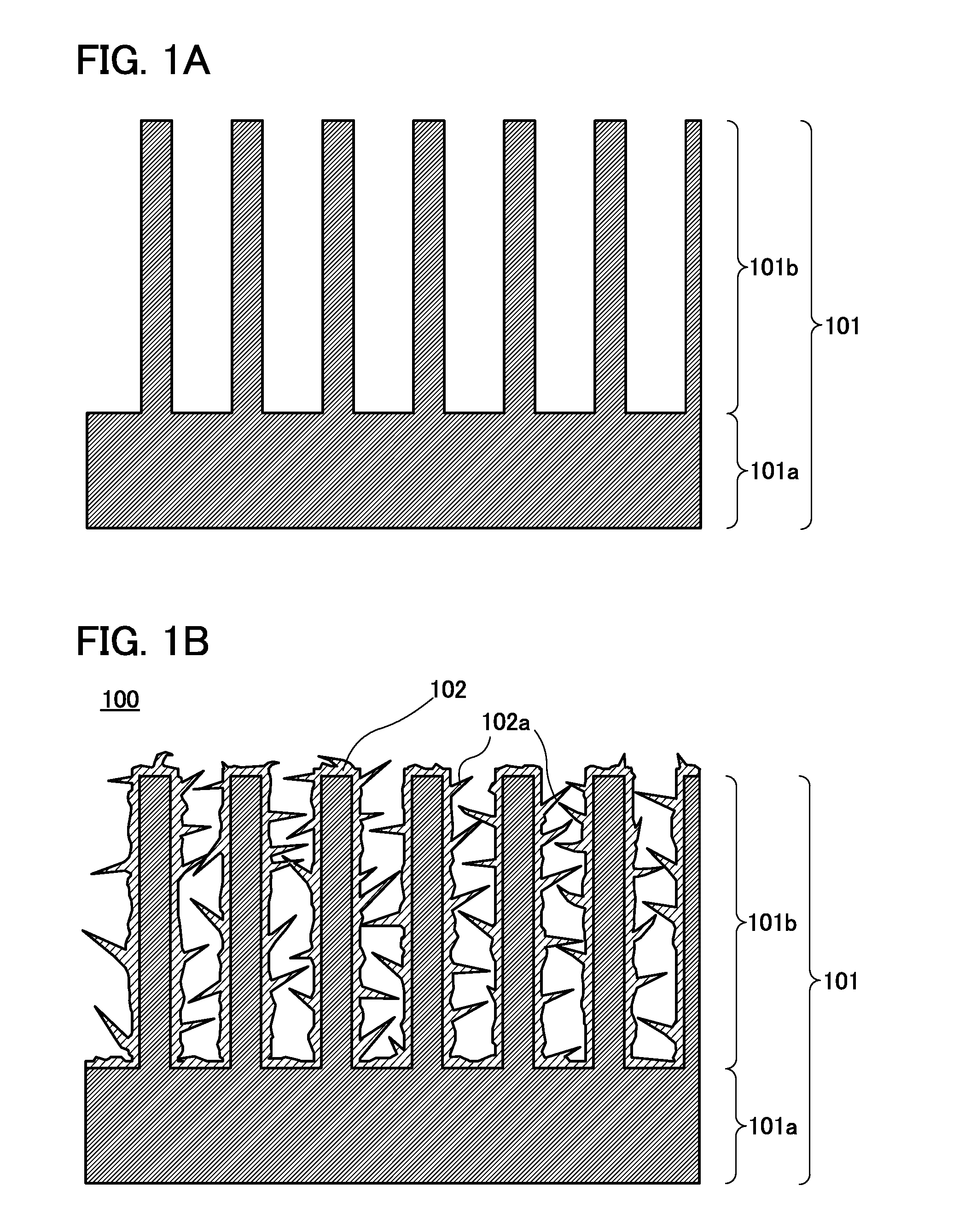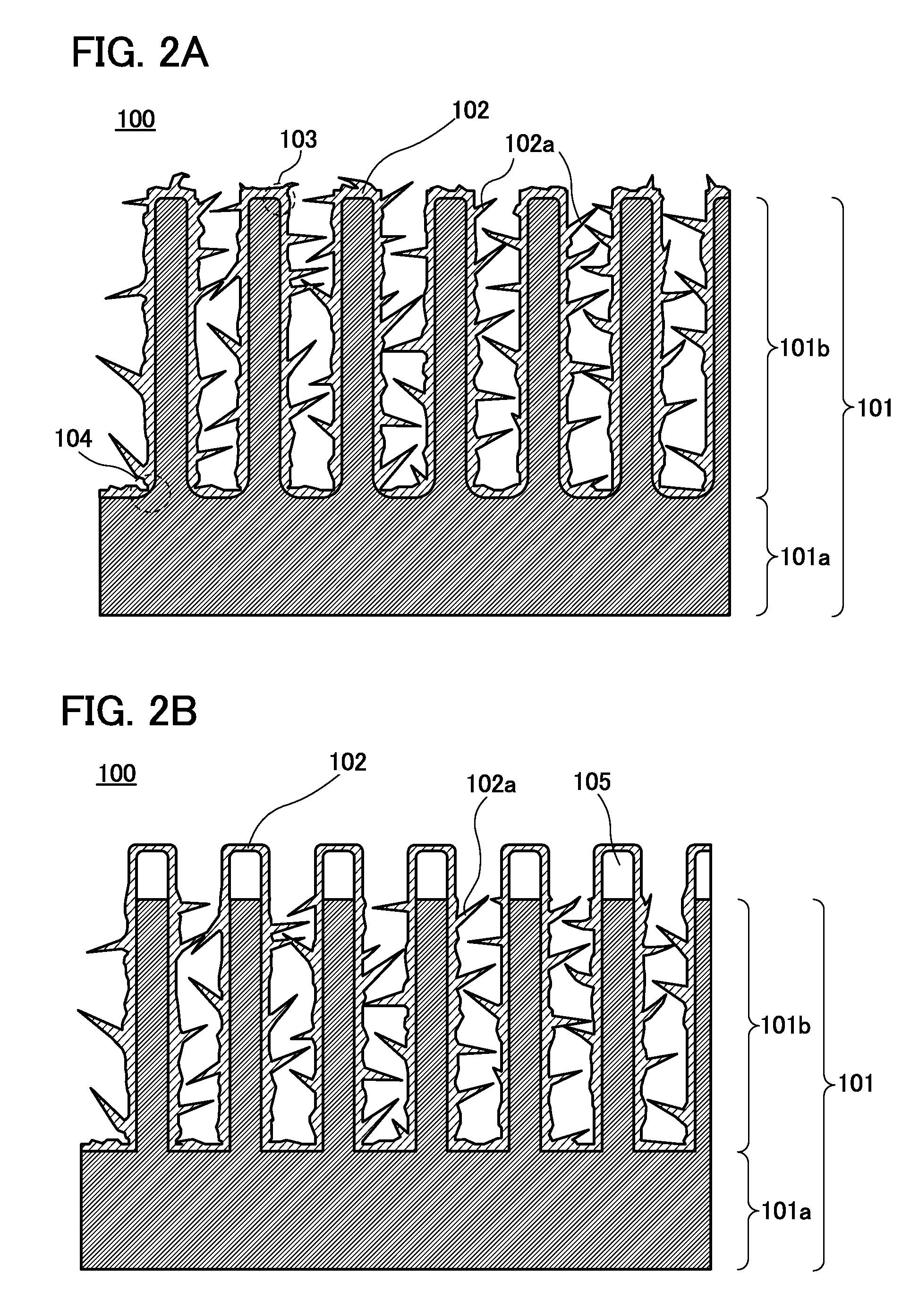Negative electrode for non-aqueous secondary battery, non-aqueous secondary battery, and manufacturing methods thereof
a secondary battery and negative electrode technology, applied in the direction of fluid pressure measurement, liquid/fluent solid measurement, peptides, etc., can solve the problems of difficult maintenance of battery reliability, inability to prevent breakage of the active material layer of the negative electrode, and inability to avoid expansion and contraction of the volume, so as to increase the volume reduce the total and increase the thickness of the active material layer of the negative electrod
- Summary
- Abstract
- Description
- Claims
- Application Information
AI Technical Summary
Benefits of technology
Problems solved by technology
Method used
Image
Examples
embodiment 1
[0068]In this embodiment, a structure of a negative electrode for a non-aqueous secondary battery, which is unlikely to deteriorate by charge and discharge and has good charge-discharge cycle characteristics, and a manufacturing method of the negative electrode will be described with reference to FIGS. 1A and 1B, FIGS. 2A and 2B, FIGS. 3A to 3I, FIGS. 4A to 4D, FIGS. 5A to 5C, FIGS. 6A to 6D, FIGS. 7A to 7D, and FIGS. 8A to 8C.
[0069]The non-aqueous secondary battery is a secondary battery in which a non-aqueous electrolyte solution is used and carrier ions are used for charge-discharge reaction. In particular, a secondary battery in which lithium ions are used as carrier ions is referred to as a lithium secondary battery. Examples of carrier ions which can be used instead of lithium ions include alkali-metal ions such as sodium ions and potassium ions; alkaline-earth metal ions such as calcium ions, strontium ions, and barium ions; beryllium ions; magnesium ions; and the like.
(Struc...
embodiment 2
[0150]In this embodiment, a mode in which graphene is provided over the negative electrode active material layer of the negative electrode described in Embodiment 1 will be described with reference to FIGS. 9A to 9C.
(Structure of Negative Electrode Using Graphene)
[0151]In this embodiment, graphene refers to single-layer graphene, which is a sheet of one atomic layer of carbon molecules having sp2 bonds or multilayer graphene including 2 sheets or more and 100 sheets or less of graphene. Graphene is chemically stable, has favorable electric characteristics, and thus has been expected to be applied to channel regions of transistors, vias, wirings, and the like included in semiconductor devices; therefore, in recent years, graphene has actively been researched and developed. In this embodiment, such graphene is used for the negative electrode described in Embodiment 1.
[0152]FIG. 9A illustrates an example in which graphene 127 is applied to the negative electrode 100 which is formed by ...
embodiment 3
[0199]In this embodiment, a structure and a manufacturing method of a non-aqueous secondary battery will be described.
[0200]First, a positive electrode and a manufacturing method thereof will be described.
[0201]FIG. 11A is a cross-sectional view of a positive electrode 300. In the positive electrode 300, a positive electrode active material layer 302 is formed over a positive electrode current collector 301.
[0202]The positive electrode current collector 301 can be formed using a highly conductive material such as a metal typified by stainless steel, gold, platinum, zinc, iron, copper, aluminum, or titanium, or an alloy thereof. Note that the positive electrode current collector 301 can be formed using an aluminum alloy to which an element which improves heat resistance, such as silicon, titanium, neodymium, scandium, or molybdenum, is added. Alternatively, the positive electrode current collector 301 may be formed using a metal element which forms silicide by reacting with silicon. ...
PUM
| Property | Measurement | Unit |
|---|---|---|
| oxidation-reduction potential | aaaaa | aaaaa |
| angle | aaaaa | aaaaa |
| angle | aaaaa | aaaaa |
Abstract
Description
Claims
Application Information
 Login to View More
Login to View More - R&D
- Intellectual Property
- Life Sciences
- Materials
- Tech Scout
- Unparalleled Data Quality
- Higher Quality Content
- 60% Fewer Hallucinations
Browse by: Latest US Patents, China's latest patents, Technical Efficacy Thesaurus, Application Domain, Technology Topic, Popular Technical Reports.
© 2025 PatSnap. All rights reserved.Legal|Privacy policy|Modern Slavery Act Transparency Statement|Sitemap|About US| Contact US: help@patsnap.com



